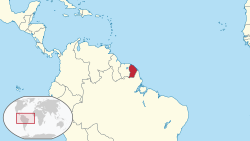Attempted Italian colonization of America facts for kids
An attempted Italian colonization in America was a plan in 1608 by Ferdinando I, the Grand Duke of Tuscany (a powerful state in Italy at the time). He wanted to create an Italian settlement in South America. This was the only time Italy tried to set up a colony in the Americas.
Contents
History of the Tuscan Plan
The idea of Italy creating colonies in the Americas was very limited. It only involved one try by the Grand Duchy of Tuscany in the early 1600s.
In 1608, Grand Duke Ferdinando I of Tuscany sent an explorer named Captain Robert Thornton. His mission was to explore the northern part of Brazil and the Amazon River. The goal was to find a good spot for a new settlement on the coast of South America. This base would help Tuscany get valuable Brazilian wood.
Thornton's Expedition to America
Ferdinando I, the Grand Duke of Tuscany, led the only Italian attempt to create a colony in the Americas.
Captain Thornton sailed for about a year. He explored areas like Guyana and Brazil, including the Amazon and Orinoco rivers. He gathered a lot of information about the land.
When Thornton returned to Livorno in Italy in July 1609, he found that Grand Duke Ferdinando I had died. The new Grand Duke, Cosimo II, was not interested in building a colony far away. Thornton had been ready to sail back to the area between the Orinoco and Amazon rivers. He planned to bring Italian settlers from Livorno and Lucca in the summer of 1609. However, the whole project was cancelled.
Thornton's ship, the 'Santa Lucia', came back to Italy in 1609. It carried many details about the area between Trinidad island and the Amazon river delta. He also brought back some native people from the Americas and a few tropical parrots.
He returned with five Arawak natives. Sadly, most of them got sick with smallpox and died. Only one Arawak person lived for several years at the Medici court. This person learned to speak Italian. These natives often talked about how rich and fertile their homeland was. They spoke of a country full of silver and gold.
Captain Thornton agreed with their stories. He said the land had many valuable resources. These included rosewood, wild sugar canes, white pepper, balsam, cotton, and other goods. He believed these items would create a lot of trade for the Tuscans.
The area Thornton thought about for an Italian colony is now part of modern French Guyana. It is close to Cayenne. France later colonized this area in 1630.
Modern Italian Settlements Abroad
The Italians never truly created colonies in the Americas like other European powers did. They mainly built territorial colonies in other parts of the world after Italy became a unified country in the 1800s.
However, many Italians (like Germans) moved to America to live under different flags. They created settlements of people who had moved from Italy. These places are sometimes called "colonies." These settlements were formed by groups of Italian immigrants who moved and settled together. Many of these settlements still exist today.
One of the first Italian settlements of this kind was planned for Venezuela. In the late 1830s, Luigi Castelli wanted to settle Italian immigrants from Tuscany there. This was in the same area where German immigrants later created "Colonia Tovar." Unfortunately, Castelli's ship sank in the Mediterranean Sea.
Many Italian settlements were created in the second half of the 1800s. They were mainly in Uruguay, Argentina, Chile, Mexico, and southern Brazil. This included regions like São Paulo, Paraná, Santa Catarina, and Rio Grande do Sul.
In many of these settlements, the Italian language (and its dialects) is still spoken today. Examples include "Capitán Pastene" in Chile, "Chipilo" in Mexico, or "Nova Veneza" in Santa Catarina, Brazil. In Nova Veneza, people speak a dialect called Talian.
It's important to remember that none of these immigrant settlements are connected to the Italian colonial empire of the 1900s.
See Also


